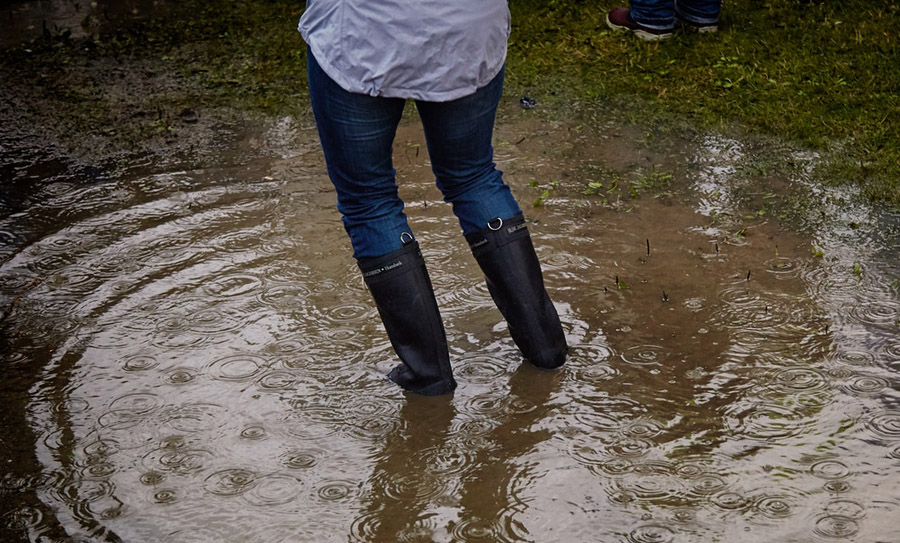Mayor Cantrell on New Orleans Drainage and Flooding
Share in:


Share in:
Mayor LaToya Cantrell held a press conference on Tuesday (May 22) to inform the public about New Orleans drainage and flooding, and to outline how her administration intends to deal with funding sources that should mitigate risk.
Cantrell called for implementing the recommendations of the Urban Water Plan, an expansive blueprint for “living with water” that would shift the emphasis from pumping water out of the city during storms to holding it in place with infrastructure such as retention and detention systems, and with innovative, green-building techniques such as rain gardens, and permeable paving.
The plan was developed under the guidance of local architecture firm Waggonner & Ball.Cantrell said she called the news conference to talk about New Orleans drainage after residents expressed anxiety over widespread street flooding following a torrential rainstorm last Friday. The storm dumped between 4-5 inches of water on the city within a couple of hours. It also overwhelmed the city’s drainage capacity, which Cantrell and Sewerage & Water Board officials said was working as expected.
“it’s a fact if we take on too much rainwater in a given hour, we will flood,” Cantrell said. “We will continue to mitigate flooding due to rainwater.”
“If you care about New Orleans like I know we all do, you need to care about stormwater and drainage,” Cantrell said. “We will never pump our way out of this, which will require us to do more.”
Much of what Cantrell talked about concerned funding streams that aren’t considered permanent sources of revenue.
But, the mayor said she is committed to implementing an urban water plan released in 2013 that includes a slew of green infrastructure projects over three parishes (Orleans, Jefferson and St. Bernard) that is expected to cost as much as $9 billion.
There have been indications that Cantrell is thinking about long-term costs of funding more modern water management infrastructure projects.
For instance, she issued a statement shortly after her innauguration that said “residents have to decide how much they are willing to pay to reduce their risk of flooding versus how much risk they are willing to tolerate.”
Asked to list policy prescriptions on her agenda that would give residents and property owners a clear picture of what they might need to pay, Cantrell focused on previous statements she made about helping property owners adopt techniques that keep water out of the city’s stormwater system.
“In terms of paying, we want to be proactive and try to create incentives to help our people live with water and mitigate stormwater on their properties. It’s about collecting water, keeping it from running into the drains,” Cantrell said.
“Working with residents who want to get rid of pavement on their properties, so there are proactive solutions we know about that are not only embedded in our urban water plan but again embedded in policies that have been adopted by organizations like the Greater New Orleans Foundation and the Urban Conservancy,” Cantrell said. “There’s help there, and it’s about linking our people to the help and where government plays a role in that, but we truly are in this together.”
The topic of incentives for property owners to install green features has often been raised amid discussions of whether to adopt a citywide stormwater fee that would help fund new infrastructure projects. A 2016 independent analysis of such a fee supports the idea — going so far as to suggest charging property owners based on how much of their property is impervious to rainwater, and granting credits to owners who install retention or detention structures, install permeable pavement and other green infrastructure.
The Bureau of Governmental Research reached a similar conclusion in a report from 2017. Stating that the city will need $54 million by 2026 — just to meet impending obligations and maintenance costs. The report also noted there is no fee structure to provide funding for those needs — let alone to build new infrastructure.
“The absence of stormwater fees in one of the nation’s most stormwater-challenged cities becomes more striking in light of the advantages such fees offer,” the report said.
Cantrell talked about discussions she’s had during recent meetings with FEMA. She cautioned that the agency doesn’t respond to disasters until 72 hours out, and said officials urged her to tell residents to get homeowners insurance. She said she also asked about renters and was told “push them to get rental insurance.”
“What we’re seeing at the federal level is that they’re willing to help us,” Cantrell said. “But the immediate response will be on the city of New Orleans.”
For years, when improved capacity for the drainage system in the New Orleans was discussed, the go-to logic was always, “Increasing the capacity would be expensive, and costs are not justified given these floods are only “one in 100-year” or “one in 50 year” events.
But what if those events are more frequent (as they appear to have been in the decade-plus since Hurricane Katrina)? Every five years? Every three years? Or even two or three per season (as we’ve seen this past year)? In these scenarios spending on infrastructure and stormwater management make more sense than enduing the dangers, costs, and hassles associated with quarterly (or more frequent) city-wide flooding.
During the most recent flood, it appears pumps were performing near full capacity — that alone should be a call to action.
It’s the obligation of city leaders and the S&WB to investigate the feasibility of upgrades, and to determine what the cost to taxpayers will be. Only then can the citizens of New Orleans assess which is the most logical path forward. Either way, and soon, New Orleans needs to address its flooding problems. S&WB upgrades are on everyone’s mind, and city officials are anxious about the potential sticker shock.
However, as Mayor Cantrell said, … we are not going to pump our way out of this.
That means: now is the time to implement the urban water plan. Now is the time to think about green building, and now is the time to start construction projects with permeable paving, and to build / re-develop the city with infrastructure such as retention and detention systems, and rain gardens.
Every resident, every business owner, and everyone in the construction industry can play a roll in building a better New Orleans. Together, we can call upon know how, and experience to build a safer, smarter city — one that is less prone to flooding, one that is better equipped to handle stormwater.

“it’s a fact if we take on too much rainwater in a given hour, we will flood,” Cantrell said. “We will continue to mitigate flooding due to rainwater.”
“If you care about New Orleans like I know we all do, you need to care about stormwater and drainage,” Cantrell said. “We will never pump our way out of this, which will require us to do more.”